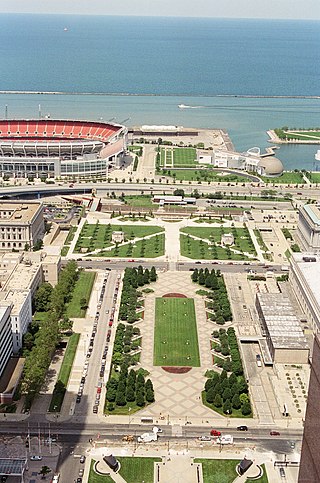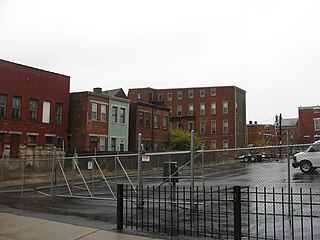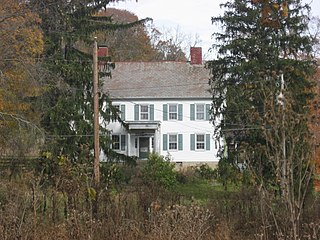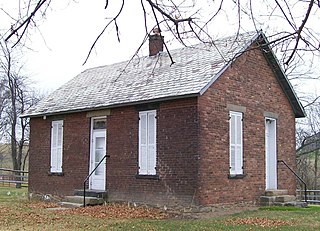
Wright Brothers National Memorial, located in Kill Devil Hills, North Carolina, commemorates the first successful, sustained, powered flights in a heavier-than-air machine. From 1900 to 1903, Wilbur and Orville Wright came here from Dayton, Ohio, based on information from the U.S. Weather Bureau about the area's steady winds. They also valued the privacy provided by this location, which in the early twentieth century was remote from major population centers.

The Indiana State Soldiers and Sailors Monument is a 284 ft 6 in (86.72 m) tall neoclassical monument built on Monument Circle, a circular, brick-paved street that intersects Meridian and Market streets in the center of downtown Indianapolis, Indiana. In the years since its public dedication on May 15, 1902, the monument has become an iconic symbol of Indianapolis, the state capital of Indiana. It was added to the National Register of Historic Places on February 13, 1973 and was included in an expansion of the Indiana World War Memorial Plaza National Historic Landmark District in December 2016. It is located in the Washington Street-Monument Circle Historic District. It is also the largest outdoor memorial and the largest of its kind in Indiana.

Dayton Aviation Heritage National Historical Park is a United States National Historical Park in Dayton, Ohio that commemorates three important historical figures—Wilbur Wright, Orville Wright, and poet Paul Laurence Dunbar—and their work in the Miami Valley.

The Wayne County Building is a monumental government structure located at 600 Randolph Street in Downtown Detroit, Michigan. It formerly contained the Wayne County administrative offices – now located in the Guardian Building at 500 Griswold Street – and its courthouse. As Wayne County Courthouse, it was listed on the National Register of Historic Places in 1975. When it was completed in 1902, it was regarded as "one of the most sumptuous buildings in Michigan".

The Cleveland Mall is a landscaped public park in downtown Cleveland, Ohio. One of the most complete examples of City Beautiful design in the United States, the park is a historic site listed on the National Register of Historic Places.

The Northside United Methodist Church is a historic Methodist church in the Northside neighborhood of Cincinnati, Ohio, United States. Constructed in the 1890s for a congregation more than sixty years old, the building has been named a historic site.

Police Station Five was a historic police station in the West End neighborhood of Cincinnati, Ohio. Constructed in the 1890s to serve both regular police and the city's patrol service, it was named a historic site in the late twentieth century, but historic designation was unable to save it from destruction.

The Riddle–Friend House is a historic residence in Wyoming, Ohio. Constructed in the early nineteenth century, it has been home to some of the area's earliest residents, and it has been named a historic site as a rare survivor of the city's earliest years.

The Adams–Gray House is a historic farmhouse in the community of Adams Mills, Ohio. Constructed in the 1840s in two separate counties, it has been named a historic site.

The Ocean Park Historic Buildings are a group of four religious community structures in the center of the Ocean Park area of Old Orchard Beach, Maine. Also known as Temple Square, they form the heart of the summer camp meeting established in 1881. The buildings include The Temple, one of the only octagonal church buildings in the state. The buildings were listed as a historic district on the National Register of Historic Places in 1982.

The Lindsey Building is a historic commercial building in the downtown section of the city of Dayton, Ohio, United States. Built in the early twentieth century, the Lindsey has been named a historic site.

The Concord Hicksite Friends Meeting House is a historic Friends meeting house located near the community of Colerain, Ohio, United States. Constructed in 1815 for a group formed in 1801, it has been named a historic site.

The Frederick Kindleberger Stone House and Barn is a historic farmstead in the rural southeastern region of the U.S. state of Ohio. Located near the village of Clarington in Monroe County, the complex is distinguished by its heavy masonry architecture, and it has been named a historic site.

Bethel Methodist Church is a historic Methodist church building in rural Clermont County, Ohio, United States. Built in the 1810s under the leadership of one of Ohio's earliest Methodist preachers, it has survived the death of its congregation, and it remains in use for community activities. Together with its cemetery, the building continues to be used occasionally, and it has been named a historic site.

St. Elizabeth of Hungary Shrine is a historic Roman Catholic shrine in the Buckeye Road neighborhood on the east side of Cleveland, Ohio, United States. The earliest ethnic parish established for Hungarians in the United States, its present building was constructed in the early twentieth century, and it has been named a historic site. In 2023, it was declared a shrine church by Bishop Edward Malesic for the promotion of the Christian heritage of the Hungarian people as well divine worship according to the liturgical books in use prior to the reforms of Pope Paul VI, and is presently operated by canons of the Institute of Christ the King Sovereign Priest.

The First Universalist Church of Olmsted is a historic Unitarian Universalist church in the city of North Olmsted, Ohio, United States. The second-oldest church building in Cuyahoga County, it has been a community landmark since the middle of the nineteenth century, and it was officially named a historic site in the late twentieth.

The Heritage, formerly known as the Journal Record Building, Law Journal Record Building, Masonic Temple and the India Temple Shrine Building, is a Neoclassical building in Oklahoma City, Oklahoma. It was completed in 1923 and listed on the National Register of Historic Places in 1980. It was damaged in the 1995 Oklahoma City bombing. It houses the Oklahoma City National Memorial Museum in the western 1/3 of the building and The Heritage, a class A alternative office space, in the remaining portion of the building.

Holy Trinity Greek Orthodox Church is a historic Greek Orthodox church building near downtown Steubenville, Ohio, United States. Constructed for a large Methodist Episcopal congregation in the early twentieth century, it was acquired by the present occupants in 1945. Featuring Neoclassical elements such as a large dome and a prominent colonnade, it has been named a historic site.

The Glenford Bank is a historic bank in the small village of Glenford, Ohio, United States. Built in the early twentieth century, the building has served as a core component of village life for much of its history, and it has been named a historic site because of its distinctive architecture.

The Oklahoma Judicial Center is the headquarters of the Oklahoma Supreme Court, the Oklahoma Court of Criminal Appeals, and the Judiciary of Oklahoma. Situated near the Oklahoma State Capitol, the original structure, designed by the architectural firm Layton, Hicks & Forsyth, was built between 1929-1930 as the home of the Oklahoma Historical Society and was listed on the National Register of Historic Places as the Oklahoma Historical Society Building in 1990. The society moved to the nearby Oklahoma History Center when it opened in 2005. An annex was completed in 2011.






















